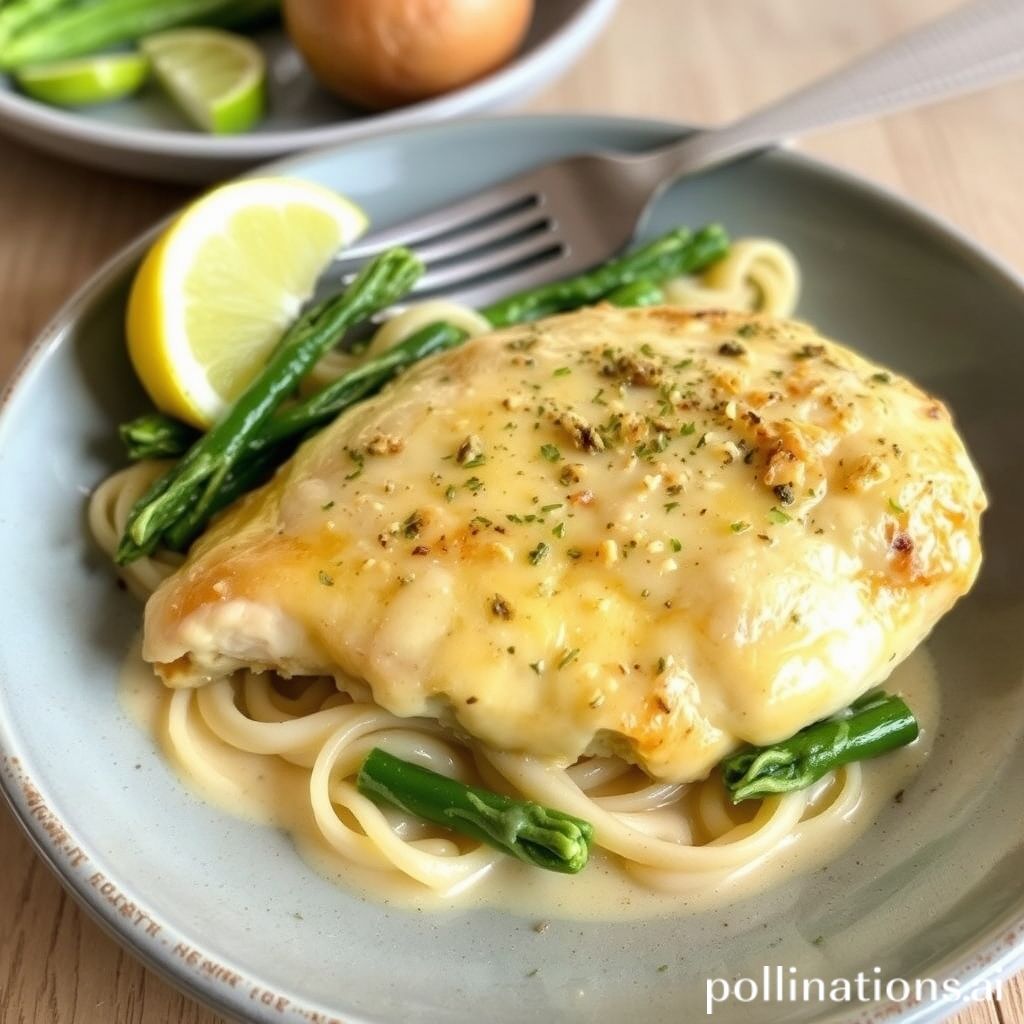Table of Contents
- Introduction
- Ingredients required for a Lemon Herb Roasted Chicken
- Step-by-step preparation of Lemon Herb Roasted Chicken
- Tips for perfecting the lemon herb marinade
- Pairing and serving suggestions for Lemon Herb Roasted Chicken
- Health benefits of using fresh herbs and lemon in chicken recipes
- Conclusion
- Frequently Asked Questions
Introduction

Imagine the aromatic symphony of fresh herbs serenading your senses, with each note perfectly complemented by the zesty brightness of lemon. This culinary masterpiece is the Lemon Herb Roasted Chicken, a dish that transforms an ordinary dinner into a celebration of flavors. Whether you are hosting a cozy family gathering or seeking a comforting solo indulgence, this recipe is destined to become a staple in your culinary repertoire.
The journey begins with a simple yet exquisite array of ingredients: juicy lemons, fresh herbs like thyme and rosemary, garlic cloves, olive oil, salt, pepper, and of course, a whole chicken, prepared to perfection. As you embark on this flavorful journey, each step promises to elevate your cooking game, unraveling secrets of culinary excellence that transform humble ingredients into a gourmet delight. Get ready to discover how to unlock the full potential of flavor in this timeless dish, as this guide takes you through every step to achieve the perfect lemon herb roasted chicken. Your taste buds are in for an unforgettable adventure!
Ingredients required for a Lemon Herb Roasted Chicken
Creating the perfect Lemon Herb Roasted Chicken starts with gathering fresh and flavorful ingredients. A whole chicken, approximately 4 to 5 pounds, serves as the centerpiece of this dish. To infuse it with a zesty flavor, you will need two fresh lemons — one for juicing and the other thinly sliced.
Next, select a combination of fresh herbs such as rosemary, thyme, and parsley, which will add aromatic depth to the chicken. Aim for about a handful or roughly a quarter cup of each herb, finely chopped. Garlic is another essential for adding boldness; six cloves, minced, should be sufficient.
Olive oil acts as a base for the marinade, use about 1/4 cup to ensure the chicken remains succulent during roasting. Additionally, season the chicken generously with salt and pepper to enhance all the flavors. For an extra touch of richness, consider using a tablespoon of melted butter to coat the skin before roasting.
To complete the dish, have a few vegetables like carrots and onions on hand for roasting alongside the chicken, absorbing the lemony herbal juices. With these ingredients, your Lemon Herb Roasted Chicken will be bursting with flavor.
Step-by-step preparation of Lemon Herb Roasted Chicken
Start by preheating your oven to 425°F (220°C). Prepare the chicken by removing any excess fat and patting it dry with paper towels. This step ensures a crispy skin. Inside the cavity, season generously with salt and pepper. Next, stuff the cavity with lemon slices, a few garlic cloves, and fresh herbs such as thyme and rosemary. This infuses the chicken with aromatic flavors as it roasts.
In a small bowl, mix olive oil, lemon juice, minced garlic, chopped herbs, salt, and pepper. Rub this mixture over the entire chicken, ensuring that it’s well-coated for a flavorful crust.
Place the chicken breast-side up on a roasting pan. Roast in the oven for about 1 to 1.5 hours, or until the internal temperature reaches 165°F (74°C). Baste occasionally with the pan juices to keep the chicken moist and enhance flavor.
Once roasted, remove the chicken from the oven and let it rest for 10-15 minutes before carving. This step allows the juices to redistribute, making the meat tender and juicy. Serve your lemon herb roasted chicken with your choice of sides for a delightful meal.
Tips for perfecting the lemon herb marinade
To truly perfect your lemon herb marinade for roasted chicken, it’s essential to balance flavors and allow enough time for the chicken to absorb all the aromas. Start by choosing fresh herbs like rosemary, thyme, and parsley, which are key to adding an aromatic depth. Mince them finely so that they release their essential oils, enhancing the marinade’s flavor.
Lemon is another cornerstone of your marinade, offering a tangy freshness. Use fresh lemon juice for a natural zest, and include some zest from the peel for added citrus notes. To ensure the flavors meld beautifully with the chicken, incorporate extra virgin olive oil, which acts as a carrier, helping the marinade to penetrate deeply.
Don’t forget to season with salt and pepper, which will not only enhance the flavor but also help tenderize the meat. Allow the chicken to marinate for at least two to four hours, or overnight for more intense flavor infusion. Remember to occasionally turn the chicken to ensure even coating. Adding a touch of honey can introduce a hint of sweetness, balancing the acidity from the lemon.
By following these tips, your lemon herb roasted chicken will be bursting with flavor and perfectly juicy.
Pairing and serving suggestions for Lemon Herb Roasted Chicken
Lemon Herb Roasted Chicken is a versatile dish that pairs beautifully with a variety of sides, enhancing its fresh and aromatic flavors. To complement the zesty and savory notes of the chicken, consider serving it with a light and refreshing salad, such as a mixed greens salad adorned with seasonal vegetables. The crisp texture and vibrant flavors will balance the richness of the roasted chicken.
For a heartier accompaniment, roasted or mashed potatoes are an excellent choice. The creaminess of mashed potatoes or the crispy texture of roasted potatoes add a comforting element to the meal. To introduce a bit of color and nutrition, you can also add steamed asparagus or green beans, tossed with a hint of lemon and butter, to underscore the citrus theme.
If you prefer a grain option, consider serving lemon herb roasted chicken with a fluffy quinoa pilaf or a nutty wild rice blend. These grains absorb the juices of the chicken beautifully, enhancing each mouthful with their subtle flavors.
For drinks, a chilled glass of white wine, such as Sauvignon Blanc or Chardonnay, complements the dish’s citrusy and herbal qualities. Alternatively, a sparkling water infused with a slice of lemon can provide a non-alcoholic refreshment that’s equally delightful.
Health benefits of using fresh herbs and lemon in chicken recipes
Incorporating fresh herbs and lemon into chicken recipes not only enhances flavor but also provides numerous health benefits. Fresh herbs such as rosemary, thyme, and parsley are packed with essential nutrients and antioxidants. These herbs contain vitamins A and C, iron, and calcium, which help boost the immune system, improve vision, and promote healthy skin. The antioxidants in fresh herbs also play a crucial role in reducing inflammation and combating free radicals in the body.
Lemon, on the other hand, is a powerhouse of vitamin C, which is essential for maintaining a healthy immune system. Additionally, lemon juice aids in digestion and helps detoxify the liver, contributing to overall wellness. The citric acid in lemon can also enhance iron absorption, ensuring that your body efficiently uses this vital mineral.
Together, fresh herbs and lemon provide a natural way to season chicken, reducing the need for excessive salt or unhealthy fats, making your dish not only delicious but also nutritious. By incorporating these ingredients, you can elevate a simple chicken recipe into a health-boosting meal packed with beneficial compounds that support various bodily functions and promote optimal health.
Conclusion
The exploration of a perfect lemon herb roasted chicken doesn’t stop at mere ingredients and cooking steps. With the insights and techniques shared in this guide, you can elevate your culinary skills and create a delectable meal that tantalizes the taste buds. The harmonious blend of fresh herbs and zesty lemon not only imparts an incredible aroma but also a nutritious boost to your dish. Serve it with your favorite sides, and you have a wholesome meal that’s impressive and satisfying.
For those eager to diversify their chicken repertoire, why not take it a step further? Unlock endless possibilities and avoid mundane meals with The Chicken Bible: Say Goodbye to Boring Chicken with 500 Recipes for Easy Dinners, Braises, Wings, Stir-Fries, and So Much More. This comprehensive guide is an essential companion for any kitchen, offering a vast array of delicious recipes that redefine chicken cooking. Ready to transform your chicken dishes forever? Purchase now on Amazon and embark on a culinary adventure today!















